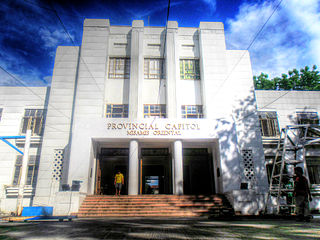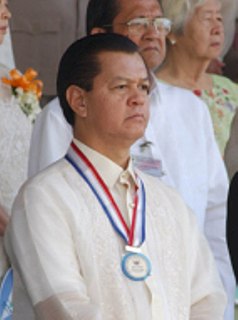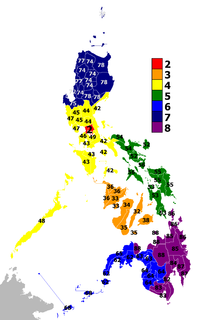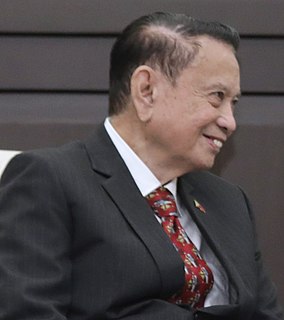
This is a list of Vice Presidents of the Philippines by place of primary affiliation. Some vice presidents have been born in one province, but are commonly associated with another.

This is a list of Vice Presidents of the Philippines by place of primary affiliation. Some vice presidents have been born in one province, but are commonly associated with another.
| No. | Vice President | Province |
|---|---|---|
| 1 | Sergio Osmeña | Cebu |
| 2 | Elpidio Quirino | Ilocos Sur |
| 3 | Fernando Lopez | Iloilo |
| 7 | ||
| 4 | Carlos P. Garcia | Bohol |
| 5 | Diosdado Macapagal | Pampanga |
| 6 | Emmanuel Pelaez | Misamis Oriental |
| 8 | Salvador Laurel | Batangas |
| 9 | Joseph Estrada | Metro Manila [1] |
| 10 | Gloria Macapagal Arroyo | Pampanga |
| 11 | Teofisto Guingona Jr. | Misamis Oriental [2] |
| 12 | Noli de Castro | Oriental Mindoro |
| 13 | Jejomar Binay | Metro Manila [1] |
| 14 | Leni Robredo | Camarines Sur |
| State | Vice President per province | Vice President | #th Vice President |
|---|---|---|---|
| Metro Manila [1] | 2 | Joseph Estrada | 9 |
| Jejomar Binay | 13 | ||
| Misamis Oriental | 2 | Emmanuel Pelaez | 6 |
| Teofisto Guingona Jr. | 11 [2] | ||
| Pampanga | 2 | Diosdado Macapagal | 5 |
| Gloria Macapagal Arroyo | 10 | ||
| Batangas | 1 | Salvador Laurel | 8 |
| Bohol | 1 | Carlos P. Garcia | 4 |
| Camarines Sur | 1 | Leni Robredo | 14 |
| Cebu | 1 | Sergio Osmeña | 1 |
| Ilocos Sur | 1 | Elpidio Quirino | 2 |
| Iloilo | 1 | Fernando Lopez | 3, 7 |
| Oriental Mindoro | 1 | Noli de Castro | 12 |
| Province | Vice Presidents per province | Vice President | Year inaugurated | Birthplace |
|---|---|---|---|---|
| Metro Manila [3] | 5 | Teofisto Guingona Jr. | 2001 | San Juan, Rizal [4] |
| Salvador Laurel | 1986 | Manila | ||
| Joseph Estrada | 1992 | Manila | ||
| Jejomar Binay | 2010 | Manila | ||
| Gloria Macapagal Arroyo | 1998 | San Juan, Rizal [4] | ||
| Bohol | 1 | Carlos P. Garcia | 1953 | Talibon |
| Camarines Sur | 1 | Leni Robredo | 2016 | Naga |
| Cebu | 1 | Sergio Osmeña | 1935 | Cebu City |
| Ilocos Sur | 1 | Elpidio Quirino | 1946 | Vigan |
| Iloilo | 1 | Fernando Lopez | 1949, 1965 | Iloilo City |
| Misamis Oriental | 1 | Emmanuel Pelaez | 1961 | Medina, Misamis [5] |
| Oriental Mindoro | 1 | Noli de Castro | 2004 | Pola, Mindoro [6] |
| Pampanga | 1 | Diosdado Macapagal | 1957 | Lubao |
As of 2016, 3 out of 13 (accounting for Fernando Lopez' two non-consecutive terms) individuals (23%) were inaugurated after officially residing in a different place than their birth.
| Vice President | Birth province | Home province |
|---|---|---|
| Salvador Laurel | Metro Manila [3] | Batangas |
| Gloria Macapagal Arroyo | Rizal [4] | Pampanga |
| Teofisto Guingona Jr. | Rizal [4] | Misamis Oriental [2] |
The Provinces of the Philippines are the primary political and administrative divisions of the Philippines. There are 81 provinces at present, further subdivided into component cities and municipalities. The National Capital Region, as well as independent cities, are independent of any provincial government. Each province is governed by an elected legislature called the Sangguniang Panlalawigan and by an elected governor.

Northern Mindanao is an administrative region in the Philippines, designated as Region X. It comprises five provinces: Camiguin, Misamis Oriental, Lanao del Norte, Bukidnon and Misamis Occidental and two cities classified as highly urbanized, all occupying the north-central part of Mindanao island, and the island-province of Camiguin. The regional center is Cagayan de Oro. Lanao del Norte was transferred to Northern Mindanao from Region XII by virtue of Executive Order No. 36 in September 2001.

Misamis Occidental is a province located in the region of Northern Mindanao in the Philippines. Its capital is the city of Oroquieta. The province borders Zamboanga del Norte and Zamboanga del Sur to the west and is separated from Lanao del Norte by Panguil Bay to the south and Iligan Bay to the east. The province of Misamis was originally inhabited by Subanens who were an easy target by the sea pirates from Lanao.

Misamis Oriental is a province located in the region of Northern Mindanao in the Philippines. Its capital and provincial center is the city of Cagayan de Oro, which is governed independently from the province.

The Southwestern Tagalog Region, officially designated as MIMAROPA Region, is an administrative region in the Philippines. It was also formerly designated as Region IV-B until 2016. It is one of two regions in the country having no land border with another region. The name is an acronym combination of its constituent provinces: Mindoro, Marinduque, Romblon and Palawan.
Acronyms are popular in the Philippines. They are widely used in different sectors of Philippine society. Often, due to long full names of the institutions in the Philippines, acronyms are then utilized to shorten the name of an institution or a company in the country, making it more convenient to the majority of the Philippine population, but sometimes causing ambiguity.

Manuel Leuterio de Castro Jr., better known as Noli de Castro or "Kabayan" Noli de Castro, is a Filipino journalist, politician and was elected as senator in 2001 and as the 12th Vice President of the Philippines from 2004 until 2010, under the presidency of Gloria Macapagal-Arroyo.

The Vice President of the Philippines is the second-highest executive official of the government of the Philippines, after the President. The Vice President currently holds office at the Quezon City Reception House in Quezon City. Previously, the Vice President of the Philippines held office at the Coconut Palace, the Philippine National Bank Financial Center, and the Philippine International Convention Center, all in Pasay, Metro Manila.
The Legislative district of Mindoro was the representation of the historical province of Mindoro in the various national legislatures of the Philippines until 1951. The undivided province's representation encompassed the present-day provinces of Occidental Mindoro and Oriental Mindoro.

The Philippine Nautical Highway System, also the Road Roll-on/Roll-off Terminal System (RRTS) or simply the RoRo System, is an integrated network of highway and vehicular ferry routes which forms the backbone of a nationwide vehicle transport system in the Philippines. It is a system of roads and ports developed by the Philippine government to connect the major islands of Luzon, the Visayas and Mindanao. The 919 kilometres (571 mi) nautical highway was opened to the public on April 12, 2003 as the Strong Republic Nautical Highway (SRNH).
The Legislative districts of Oriental Mindoro are the representations of the province of Oriental Mindoro in the various national legislatures of the Philippines. The province is currently represented in the lower house of the Congress of the Philippines through its first and second congressional districts.

The senatorial districts of the Philippines were the representations of the provinces of the Philippines in the Philippine Senate from 1916 to 1935.

Telephone numbers in the Philippines follow an open telephone numbering plan and an open dial plan. Both plans are regulated by the National Telecommunications Commission, an attached agency under the Department of Information and Communications Technology (DICT).

The following outline is provided as an overview of and topical guide to the Philippines:

Teofisto Tayko Guingona Jr. is a Filipino politician who served as the 11th Vice President of the Philippines from 2001 to 2004, during the first term of President Gloria Macapagal-Arroyo. Born in San Juan, Rizal, Teofisto is a graduate of Ateneo de Manila University, where he was a working student.